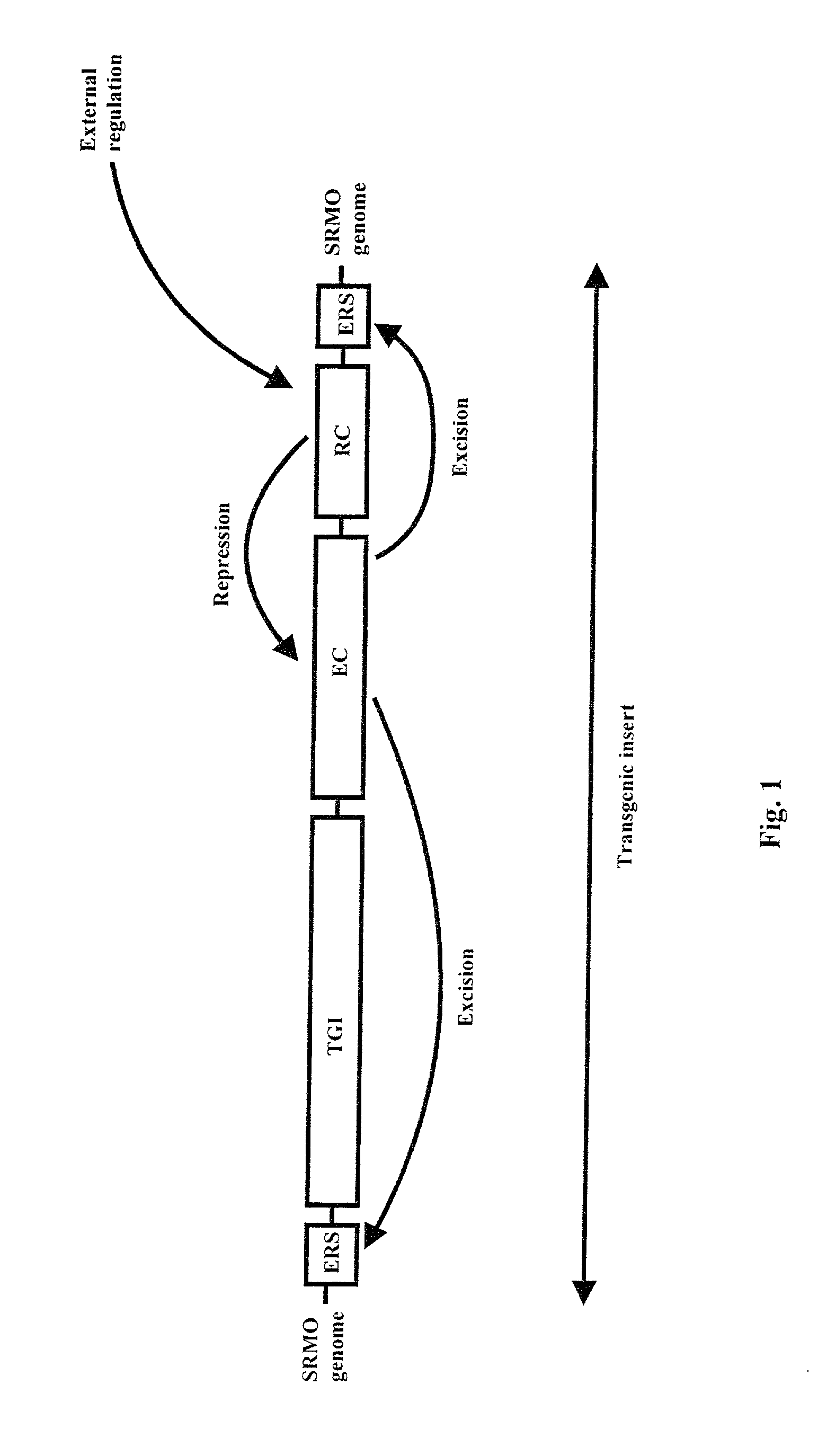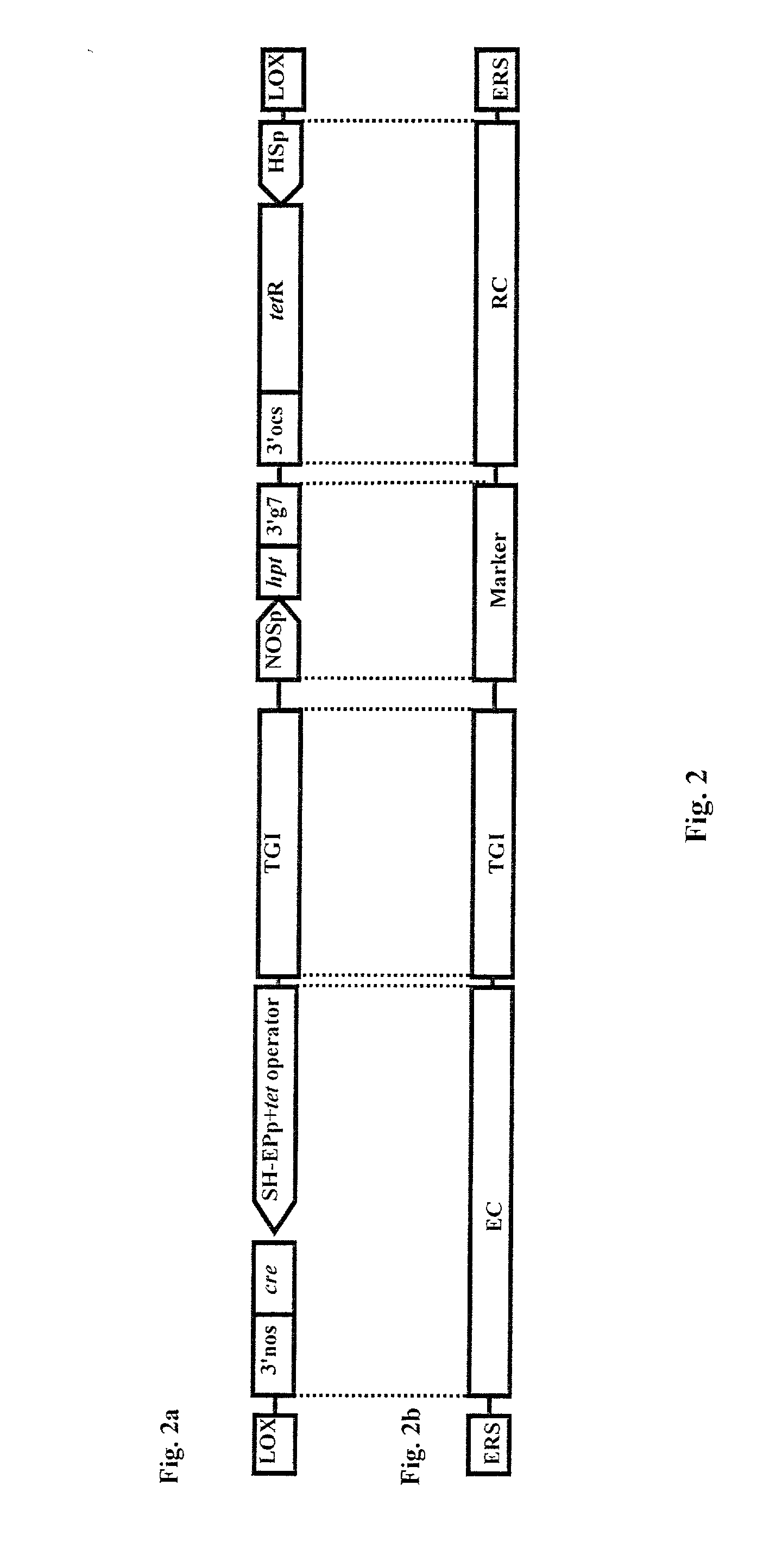Molecular control of transgene escape by a repressible excision system
a technology of excision system and gene escape, which is applied in the field of molecular control of transgene escape by a repressible excision system, can solve the problems of inability to rescue, the impact of gene escape is more complex to assess, and the use of transgene seed is limited to one generation
- Summary
- Abstract
- Description
- Claims
- Application Information
AI Technical Summary
Benefits of technology
Problems solved by technology
Method used
Image
Examples
example 1
[0117] General Repressible Excision System (RES)--One Transgenic Insert in Tobacco Plants
[0118] The transgenic insert comprises the GUS (uidA) gene as a representative of a transgene of interest (TGI), the cre recombinase gene and the Tn10 tet operator-repressor system. The insert is flanked by loxP excision recognition sites (ERSs). The GUS gene is placed under the control of CaMV 35S promoter. The chimeric cysteine-endopeptidase promoter (SH-EPp) from Vigna mungo (Akasofu, et al., 1990), with inserted tet operator sequences, regulates the cre recombinase expression. The Tn10 tet repressor gene is regulated by the heat shock promoter (HSp) from soybean (Czarnecka, et al. 1989). The model is schematically shown in FIG. 2. Additionally, the loxP sites are flanked on both sides by tet operator sequences. Alternatively, other promoters can be used. For example, cre recombinase can be regulated by modified late embryogenesis activated (LEA) or malate synthase (MS) promoter. The Tn10 tet...
example 2
[0120] Delayed Repressible Excision System (RES) in Tobacco and Turnip Rape
[0121] The first transgenic insert contains the GUS (uidA) gene as a representative of the transgene of interest (TGI) linked to the cre recombinase gene. The insert is flanked by the specific lox excision recognition sites (ERSs). The second transgenic insert is located on a different non-allelic chromosome and contains a part of a sense cre RNA and an antisense cre mRNA. The GUS gene is placed under the control of the CaMV 35S promoter. The cre gene is placed under the control of the NOS promoter (NOSp). The antisense cre gene is regulated by the CaMV 35S promoter. A 600 bp long fragment of cre gene is regulated by NOSp. Both constructs are in homozygous condition. The promoter of the cre recombinase is continuously repressed by an antisense RNA silencing mechanism. The DNA constructs are schematically shown in FIG. 3.
[0122] Introline crossing keeps both of the transgenic inserts in homozygous condition, an...
example 3
[0123] Combined RBF and RES Systems in Triple RBF / RES
[0124] The schematic structures of the constructs used in a combined recoverable block of function (RBF) / repressible excision system (RES) are presented in FIG. 4. Three transgenic inserts are introduced into different non-allelic chromosomes and are in homozygous conditions. The first insert contains cre recombinase gene under the control of nos promoter and a barstar gene under the control of the CaMV 35S promoter. The insert is flanked by LoxP sites in the same orientation. The second insert contains the barnase gene under the control of the chimeric cysteine-endopeptidase (SH-EP) promoter as well as the antisense cre and 600 bp fragment of the sense cre recombinase, both under the control of the CaMV 35S promoters. The third insert contains transgene(s) of interest (TGIs) flanked by cre recombinase on one side and barnase on the other side of the insert. The LoxP sites are placed in the insert as shown in FIG. 4. The interacti...
PUM
| Property | Measurement | Unit |
|---|---|---|
| Electrical conductance | aaaaa | aaaaa |
| Temperature | aaaaa | aaaaa |
| Heat | aaaaa | aaaaa |
Abstract
Description
Claims
Application Information
 Login to View More
Login to View More - R&D
- Intellectual Property
- Life Sciences
- Materials
- Tech Scout
- Unparalleled Data Quality
- Higher Quality Content
- 60% Fewer Hallucinations
Browse by: Latest US Patents, China's latest patents, Technical Efficacy Thesaurus, Application Domain, Technology Topic, Popular Technical Reports.
© 2025 PatSnap. All rights reserved.Legal|Privacy policy|Modern Slavery Act Transparency Statement|Sitemap|About US| Contact US: help@patsnap.com



